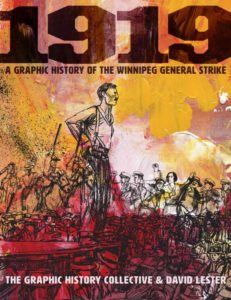Most people have too little time in their busy lives to think much about their past. We are too concerned with our next meeting or class or what our commute time looks like to worry about history. However, the things we can learn about our past can often help us shape our futures, which is why when history is delivered to us in a convenient form, we need to make the time to understand what it can teach us.
David Lester’s 1919: A Graphic History of the Winnipeg General Strike is a graphic novel that helps to break up what can easily become a rather bland subject by showing us the basics of what happened through art more than through text.
1919’s introduction sets the stage by presenting us with what is most likely a familiar scene: an overturned streetcar in the middle of a main street. This can be seen as a metaphor for how the strike overturned the city in its quest. It teaches us that while the Winnipeg strike is the most famous, many more strikes had already happened before it.
After the succinct but powerful history lesson in the introduction, the reader is given the chance to dive right into the visuals for a clear and—let’s be honest—more exciting look at what really happened.
The pencil sketch style of art almost makes it feel as though the reader is watching a black-and-white film while still showcasing the importance of the event. Although this format may not be able to go as deep into everything as a classic textbook or academic perspective, it’s a starting point.
1919 presents history in a way that minimizes the chance of the reader getting bored and picking something else to read. This provides the perfect entry point to the subject at hand.
The graphic-novel format provides a lighter tone, which is perfect for a younger audience, while not skimming over the intense violence that happened during the strike, especially on Bloody Saturday. 1919 would be a perfect resource in libraries and at schools; however, its appeal is not limited to a younger audience.
We could all do to learn a little bit more about where we came from. What previous generations had to do to get us where we are isn’t something we should take lightly. After all, we need to ask ourselves this: what are we leaving behind?

